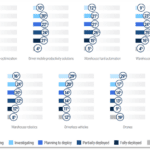In late 2023, Descartes conducted a survey of 1,000 supply chain and logistics decision-makers across North America and Europe across three sectors: manufacturing, distribution and retail; carriers; and logistics services providers. The study showed that the workforce problem is pervasive, with 76% of respondents indicating they are facing notable shortages. The study also provided insight into what companies are doing to address it.
The research report What Are Companies Doing to Survive the Supply Chain and Logistics Workforce Challenge? shows that 54% of the leaders surveyed are focused on automating non-value-added and repetitive tasks with technology to improve worker productivity. In addition, the report shows what companies are doing to attract and retain employees to mitigate workforce challenges today and in the future. As companies continue to grapple with the issue, the following charts help to illustrate the top technology choices they are using to help drive productivity gains for labor workers and knowledge workers, as well as the tactics they are using to both attract new employees and keep existing ones.
Delivery route optimization is the top tech choice to improve the productivity of labor workers.
Given that transportation operations were cited in the study as the area suffering the most from resource constraints, it’s no surprise that delivery route optimization was the technology most deployed (54% partially/fully deployed) to improve the productivity of labor workers. For companies that view their supply chain and logistics operations as a competitive weapon, 63% had partially/fully deployed route optimization versus just 28% for those where it’s viewed as a necessary evil. A significant partially/fully deployed variance was also seen with driver mobile productivity solutions: 56% for competitive weapon respondents versus 35% for necessary evil ones.
Figure 1: Technologies that have/will be deployed to mitigate labor worker shortages
Source: Descartes & SAPIO Research
Real-time shipment tracking is the top tech choice to improve the productivity of knowledge workers.
The automation opportunity is not only for laborers, but also for knowledge workers who spend an inordinate time preparing data and running reports rather than conducting higher-value analysis and planning. To improve the productivity of knowledge workers in supply chain and logistics operations, automated real-time shipment tracking (53%) was the technology most cited as partially/fully deployed. In the face of growing customer demand for visibility, without automation, shipment tracking is prohibitively manual (e.g., calls, emails) and resource-intensive. Back-office automation and advanced analytics were tied at 47% for partially/fully deployed. AI—which leads all other options in market hype—was the lowest partially/fully deployed response (32%).
Companies are changing their hiring strategies to attract workers.
Workforce shortages have caused over 50% of respondents to make significant changes to their hiring strategies for laborers and knowledge workers. Working time flexibility (35%) was the tactic most cited as used significantly to attract workers, closely followed by adopt latest technology (34%). Both approaches play favorably to millennial and Gen Z demographics. Higher pay was third (31%) for significantly used, and the lowest not used at all (15%). Competitive weapon respondents were even more focused on working time flexibility (39%) and adopt the latest technology (42%) while necessary evil ones were less focused on both, with working time flexibility at 26% and adopt latest technology at 28%.
Retention strategies are also changing to keep workers.
Following the younger worker theme, investing in workforce skills is also very important to retaining workers in this demographic. On-the-job training and education compensation (35%) was the top significantly used tactic followed closely by higher pay (34%). Interestingly, almost half (49%) of necessary evil respondents did not offer higher pay to retain workers compared to competitive weapon respondents (23%). Work time flexibility was much more likely to be significantly used by competitive weapon respondents (31%) than necessary evil ones (16%).
The study confirms that most supply chain and logistics organizations have made changes to their operational, technology, recruitment and retention strategies to address workforce challenges. Going forward, the winners in the talent war will recognize that they must continue to invest and evolve to combat workforce challenges. What changes is your organization making to address the issue? Let me know.
As Executive Vice President, Solutions and Services, Chris Jones is primarily responsible for Descartes industry consulting and implementation services for Descartes’ solutions. With over 40 years of experience in the supply chain market, Chris has held a variety of leadership positions including: Senior Vice President at The Aberdeen Group’s Value Chain Research division, Executive Vice President of Marketing and Corporate Development for SynQuest, Vice President and Research Director for Enterprise Resource Planning Solutions at Gartner and Associate Director Kraft General Foods. Chris is a thought leader in logistics and has numerous articles and blog posts published in leading logistics and supply chain publications and online forums across the globe. He has a Bachelor of Science in Electrical Engineering from Lehigh University.
The post How Supply Chain & Logistics Companies are Mitigating Labor Shortages appeared first on Logistics Viewpoints.
